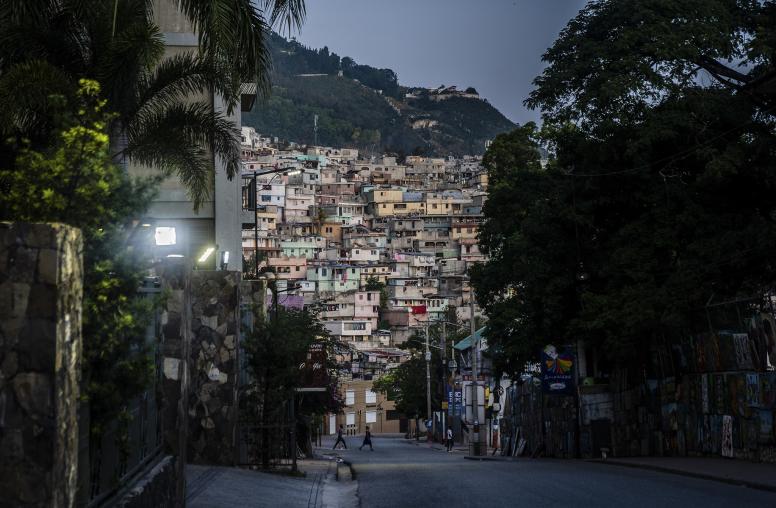Up an unpaved track, about a two-hour drive from the nearest town in the eastern Andes, sits a small village that could be mistaken for a Colombian hamlet of crude dwellings and vegetable gardens. But appearances aside, something extraordinary is going on here. The outpost’s population, comprised entirely of former guerrillas who fought for the Revolutionary Armed Forces of Colombia, the FARC, is engaged in an unplanned experiment in building peace.

The village, known as Simon Trinidad, is among a score or so of communities where FARC ex-combatants are collectively settling into new lives and economic activities, rather than pursuing individual reintegration under Colombia’s 2006 Social and Economic Reintegration Policy. In these communities, emerging on the sites of government demobilization camps after the 2016 peace agreement, the FARC is maintaining its structure and identity as it transitions from armed group to legal political party.
“If you live here you have to understand how we work as a community and join the effort,” Delia, a former FARC prisoner released under the peace deal, said during on a tour of the site. All residents of Simon Trinidad work together as a single cooperative, organized around production of organic fertilizers and food crops, and pig farming, she said. They also take courses to earn a high-school diploma and attend multiple workshops.
The peace accords signed by the FARC and the Colombian government provided for this novel approach to dealing with former fighters. Besides the customary individual process that has accompanied other disarmament, demobilization and reintegration efforts, the government agreed to support what is called collective, economic and social reincorporation.
Collective reincorporation under the peace deal contemplated that FARC communities might endure as social, political and economic units, but no one expected the transition zones to molt into towns. Whether these communities are sustainable remains to be seen. It can already be said, however, that Colombia’s pathbreaking collective reincorporation points to a possible post-conflict model for other countries where it’s viable and desirable.
From Transition Zones to Reincorporation Spaces
The distinctive collective focus started with 20 “transition zones” established under the accord in scattered rural areas as places for FARC members to live while demobilizing. The government provided basic construction materials to build camps with bedroom units, and communal bathrooms and kitchens. The former guerrillas (about 7,000 men and women) were expected to spend about 180 days at the sites.
Now called “Reincorporation Spaces,” the transition zones have acquired a semi-permanent status and become central to collective reincorporation, supported by government financing and assistance for productive projects. The peace accords called for support of “productive projects” initiated by ex-guerrillas, and the zones have become vital to transforming individual projects into a web of collective enterprises. The material and economic resources for the projects are administered by a FARC-run fund called ECOMUN, while the projects themselves are implemented through locally controlled cooperatives. Some zones feature a single cooperative with assorted productive arms, while others have set up separate coops specializing in activities that include food production, tourism, baking, tailoring and lodging services.
More than providing a spatial infrastructure for the implementation of productive projects, the zones offered incentives for the FARC to make peace and maintain it. They allow the FARC to put down its weapons while maintaining its party infrastructure and political enterprise. Local leaders of the zones are appointed by the FARC secretariat that also controls reintegration funds, letting leaders who bought into the peace process retain their status and influence. At the same time, the zones, situated in the home areas of the armed groups’ members, have become secure centers from which the FARC can peacefully spread its leftist political message as a legal party in regional and local elections in October.
Civilian Life
While the government has been unwilling or unable to protect individual rural activists following the peace agreement, the military has effectively secured the collective reincorporation zones. The zones also give the government insight on where the former guerrillas are and what they’re doing, facilitating monitoring of the reincorporation process. It remains to be seen whether the continuing presence of the FARC in areas it once controlled militarily helps fill a political vacuum that, experience shows, will otherwise draw disruptive and criminal elements.
Reliable security also supports a return to normal, civilian life for the ex-combatants. Although problems in the zones have led many to leave—two are shutting down after an exodus of residents—new people are arriving, transforming individual dorm rooms into family homes. As the Colombian peace commissioner’s team managing the zones put it, “The prospect of peace is correlated with a baby boom.” Indeed, the multitude of strollers parked in communal areas where ex-fighters organize businesses or attend lessons speaks loudly to their hopes for the future.
Still, the outlook for the zones remains murky. The two-year grace period set for these spaces by the peace agreement expires by the middle of this year. Given that the accord didn’t contemplate direct access to land ownership for demobilized FARC, the zones’ sustainability hinges on the government continuing to rent or buying the land and giving property rights to the FARC or its members—a process made difficult by the chaotic state of land titling in rural Colombia. Other challenges include the isolation of productive projects from markets, lack of capital for development and an uneasy balance of power between central and local FARC authorities.
The value of collective reincorporation, and the zones that support it, in resolving any particular conflict will depend, obviously, on local conditions. But Colombia’s novel experiment, whatever its future, has demonstrated that it can be one tool in the kit for demobilizing large insurgent groups with political agendas. It is something to consider for other nations seeking to push forward their own peace processes.
Maria Atuesta is a doctoral candidate at the Graduate School of Design at Harvard University and a USIP Jennings Randolph-Minerva Peace Scholar currently conducting fieldwork in Colombia.


